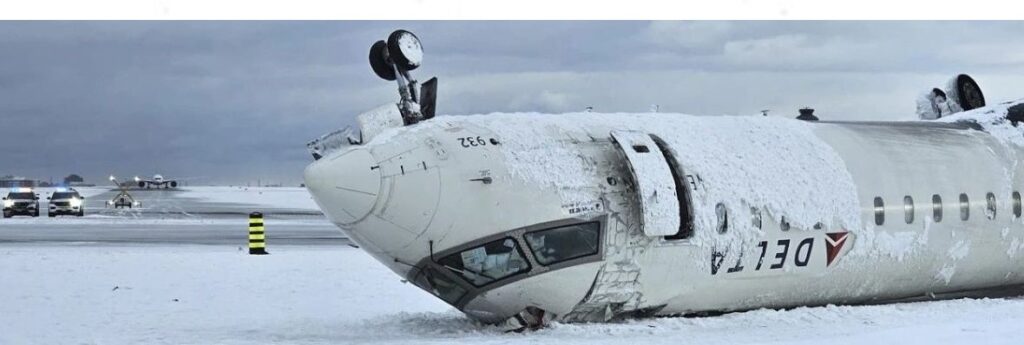After watching videos of a Delta Air Lines jet catch fire upon landing and flip over on a Toronto runway, it’s fair to wonder how anyone could have survived. But aviation experts said it was not surprising that all 76 passengers and four crew walked away from Monday’s disaster, with 21 people suffering minor injuries and only one still hospitalized on Wednesday. It’s a credit, they said, to advances in plane design as well as a crew that flawlessly executed an evacuation plan.
“When I first saw (footage of) that aircraft upside down at the airport, I was like: ‘How can that happen? And how can anybody survive that?’” Michael McCormick, an assistant professor and program coordinator for air traffic management at Embry-Riddle Aeronautical University in Daytona Beach, Fla., said. “It was absolutely astounding to watch the people actually climbing out.”
Passenger jet design a factor
McCormick and others said the fact that there were only minor injuries shows that passenger jet design and engineering have greatly improved over time.
Fuel tanks are stored in the wings, so the wings are designed to break off in a crash to remove a seriously explosive hazard, he said. The tail-like fin of a plane known as a vertical stabilizer is frangible – or easily broken – meaning an aircraft that has flipped over can stay flat on the ground and passengers and crew are able to evacuate, he said.
“Aviation is and remains the safest form of transportation,” McCormick said, adding that it was no fluke 80 people were able to walk away from the Toronto crash. “That is because the safety of aviation is constantly improving.”
Jeff Guzzetti, an airline safety consultant and a former investigator for the US Federal Aviation Administration and the National Transportation Safety Board, said the seats and seat belts also helped to prevent fatalities. He noted that passenger jet seats are designed to withstand impacts of up to 16 times the force of gravity and that the seat belts restrained the passengers who were suspended upside down as the plane slid to a halt on the runway at Toronto Pearson International Airport.
“The odds of getting injured or killed in a commercial airline accident is far less than driving in your car,” Guzzetti said.
Crew executed the evacuation plan
Experts also credited the crew, who calmly and quickly shepherded many of the passengers off the plane before emergency crews even arrived on the scene. Deborah Flint, CEO of Greater Toronto Airports Authority, called the flight crew “heroes,” while their boss, Delta CEO Ed Bastian, praised their response as a “testament to the safety that’s embedded in the systems.”
“It’s horrifying. When you look at the video you can imagine when I received the text minutes after it happened, hearing that there was a regional jet upside down on an active runway with 80 people on board, how I felt without knowing it, what was transpiring,” Bastian said in an interview with CBS Mornings.
“But the reality is that safety is embedded into our system,” he said. “Air travel in the United States is the safest form of transportation and travel there is. Period. And it’s because we train for events like this.”
What was it like inside the cabin?
Flight 4819 from Minneapolis to Toronto, operated by Delta subsidiary Endeavor Air, crashed on landing around 2:30 p.m. Monday. Videos show the plane hitting the runway hard, bursting into flames then skidding along the tarmac and flipping over.
“It was very uncomfortable, a very just solid, uncomfortable experience – forceful on the impact, sideways movement and suddenly just inverted,” Peter Carlson, a paramedic who was travelling to Toronto for a conference, said. “The only mission was to get out. I have a laceration, abrasion, some bruises on my legs, some bruises on my ribs, but alive.”
Other videos appear to show passengers scrambling out of an upside-down cabin as workers assist them off the plane onto the snowy tarmac and emergency crews hose the aircraft with water.
A Canadian investigator refused to comment on preliminary theories, although aviation experts said they will likely consider weather conditions, as well as the possibility of human error or an aircraft malfunction.
“At this point, it’s far too early to say what the cause of this accident might be,” Ken Webster, a senior investigator for the Transportation Safety Board of Canada (TSB), said in a video statement Tuesday. He said investigators will examine the wreckage and runway, and that the cockpit voice and flight data recorders are being analyzed.
If this article was shared with you by a friend or colleague, you may enjoy receiving your own copy of Travel Industry Today with the latest travel news and reviews each weekday morning. It’s absolutely free – just CLICK HERE.

